Junior classes: 5-10yrs
Our Objective – confidence, creativity, and a love of art!
Creative confidence through fun and experimentation, the way art should always be!
Lilly-Lee’s aim is to fill the visual-art gap that is present within the QLD school’s curriculum. Not only is really it important to capitalise on the creative brain growth that children are developing at this age, but it is essential for creative children to feel their gifts are acknowledged and valued. During our classes we expose the children to a vast array of art methods, styles, concepts, and materials; rotating our focus between drawing, painting, and sculpture to develop a broad artistic knowledge base.
While we cover different techniques - confidence, creativity, and a love of art, are our primary goals for this age group. Technique can be perfected as our fine motor skills develop, however, creativity tends to reduce over time surpassed by our more logical thought processes and our 'fear of failure'. So, it is important that creativity is constantly encouraged and nurtured. If young people grow and maintain their creative and experimental abilities, it allows for a more advanced and resilient way of thinking, in all aspect of life. It also allows for the ‘trials, errors, and abstract thinking’ that is required for making unique and exceptional art.
Term 4- 2025
Junior Projects
Each week we display a small selection of junior artwork along with some context of the projects we explored. Hope you enjoy them as much as we do!
Week 8 - African Tribal Necklaces
Continuing our exploration of art and culture we were inspired by African tribal traditional neck wear, including the Maasai and Pokot peoples of Kenya and Tanzania. This wearable art, in the form of distinctive beaded collars can be worn by men and women. These beautiful decorative pieces are traditionally made from local and natural materials, incorporating beads and metals such as gold. The bright, vibrant colours hold symbolism and meaning, specific to the tribe it belongs to, including social, spiritual status, or identity.


Publicly sourced images - examples only










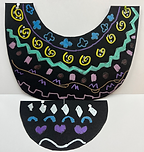


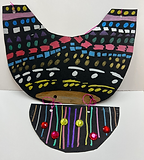












Week 7 - Clay Mushroom Wind Chimes
This week the juniors were inspired by the natural elements, focusing on mushroom heads. Taking inspiration from the artwork by Dr Sapphire McMullan-Fisher, the juniors created their own clay sculptures creating interesting texture and shapes. These sculptures were then connected by leather strips to be hung as decorative wind chimes. There was a lot of interest around the the variety of Fungi that exists.



Publicly sourced images - examples only
















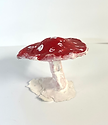










Week 6 - Watercolour and Ink Silhouettes
This week the students focused on our elements of art - Colour, contrast, shape, scale, space, texture, tone, repetition. Using watercolour transfer from tissue-paper sheets to bleed colour onto the paper in abstract background designs. Then the students used stencils and black paint to create a focal point and other details to add to their story.

Publicly sourced images - examples only













Week 5 - Colombian Flower Festival
This week following on from our round the world cultural art inspired learning, we stepped into the culture of one of our teachers, Shirley Villa Usuga. The Columbian Flower Festival or Feria de las Flores an annual event which honours the city's flower production. During this festival, the farmers (Silleteros) design and create large scale artworks using flowers (Silletas) which they carry upon their backs to parade. Our project was scaled to fit on the students wrists. To continue the cultural festivities, we finished the lesson influenced by the Japanese Koi fish kite, which are commonly made and displayed for the annual children's day festival.



Publicly sourced images - examples only















Week 4 - Eye Anatomy - in Oil Pastels
This week we investigated different types of eyes including humans, reptiles, birds and mammals. We focused on observational drawing, looking closely at the student's own eyes in mirrors and from animal references. We discussed the diverse shapes and colours that eyes can be and considered the purpose for these differences. To ensure the eyes are identifiable, we focused on the anatomy of the human and animal eyes.

Publicly sourced images - examples only































Week 3 - Decorative Borders
This week we learnt about the relevance of decorative borders. These pretty decorative designs have been found on artworks since 3000 BCE, and are still used today. The students quickly learnt that emotion and atmosphere can be communicated through their choice of borders. Some students choosing more aggressive and bold borders, and others opting for floral or lighter styles. Students worked on grid paper to allow for repetition and symmetry within their borders


Publicly sourced images - examples only






























Week 2 - Eugene Carchesio construction sculptures
We explored the realm of sculpture inspired by Brisbane/Meanjin artist Eugene Carchesio, whose work was exhibited at Milani Gallery, this month. These wonderful compositions were created without using any glue or adhesive, formed through connecting the materials physically (folding, cutting, slotting, or tying together). The project was challenging and made the students think outside the 'box', developing their creative eye and problem solving skills. What exciting outcomes!


Publicly sourced images - examples only








































Week 1 - Monet's Water Lilies
To commence the term, the students explored oil pastel and watercolour resistance in these Monet inspired Water Lily pieces. We used wet-on-wet watercolour techniques to create movement, and proportion and colour to create depth and distance. These pieces received lots of positive feedback from our older students and staff.
A special welcome to our new students, we look forward to spending the next 10 weeks exploring art together.


Publicly sourced images - examples only






























Term 3- 2025
Junior Projects
Each week we display a small selection of junior artwork along with some context of the projects we explored. Hope you enjoy them as much as we do!
Week 10 - Paper Mache Alebrijes (continued)
The Junior's completed their Alebrijes sculptures by covering them in colourful, repetitive patterns using acrylic paint. Students practiced their forward thinking throughout this project, planning ahead to create a detailed and thought-out final piece. There was a lot of fun and creativity flowing throughout the studio the past two weeks, an excellent way to finish the term. We hope everyone has a safe and creative holiday break!


Publicly sourced images - examples only
















Week 9 - Paper Mache Alebrijes
Students explored the Mexican folk art sculptures - Alebrijes, believed to provide protection. The Alebrijes are animal-like creatures made by mixing different features from different animals. Symbolic of embracing the cross over of cultures and the limitless possibilities of self expression and cultural identity. This week the students created the shape of their creature using paper mache, with the head of one animal and the body of another. Next week they will paint the distinctive colour and patterns.


Publicly sourced images - examples only

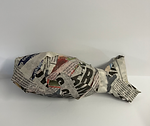





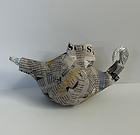








Week 8 - Fathers Day Card Making
The Junior students had the chance to use our new embossing machine, stencils, and professional card making equipment, donated to us by one of our lovely students. Despite all the shiny tools, many students still produced traditional hand-drawn card filled with heartfelt words. Happy Fathers day to all the Dads and significant others. Here is a small example of their work.















Week 7 - One-point Perspective - Minecraft
The junior students continued to expand their knowledge on perspective, focusing on one-point perspective. This perspective is characterised by the vanishing point in the centre of the horizon, with all lines angled towards this point. As many students express a fascination for Minecraft, we decided to create a Minecraft-inspired scene. A very challenging concept which was a bit tricky at times, but the students persevered, creating very successful pieces.
Publicly sourced image - example only



























Week 6 - Perspective continued - 3D Rooms
This week the junior students created a 3-Dimensional drawing, using their new understanding of perspective (from last week's lesson) to effectively convey a sense of space. This showed the students how their technical artistic knowledge can inspire creative and interesting compositions.
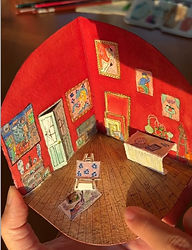
Publicly sourced image - example only



















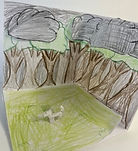




Week 5 - Principles and Elements of Art - Pizza
We explored a more technical aspects of art this week, focusing on the fundamental principles. Including: line, pattern, shape/form, rhythm/repetition, colour, proportion/scale, value/tone, scale/perspective/space, emphasis. Students can use this valuable knowledge within their future artworks to create more educated pieces. Unfortunately we only managed to photograph a few works from our lovely Tuesday afternoon class. We will build on these principals over the coming weeks.






Week 4 - Gel-pad Printing
Despite the Lilly-Lee art show's having been postponed, the junior students still worked hard creating these striking pieces to display. Exploring Gel-pad Printing techniques, using homemade gel pads, acrylic paint, and found materials from within our studio + nature.
If the students would like to make their own Gel-prints at home, here is the link to making your own Gelatine Pads.
https://kimherringe.com.au/printmaking/gelatin-plate-printmaking-recipe/


Publicly sourced image - example only

















Week 3 - 'The Son of Man' by Magritte - Reimagined
As the Lilly-Lee Art show quickly approaches, the junior students have been getting creative. The juniors are working on a large-scale collaborative piece which will be auctioned during the art show, raising money for Mummy's Wish, Charity. All proceeds will go to the foundation, encouraging students to realise their art can bring joy to others.
Students have also created a small miniature work for the exhibition.
To see the final works in person, come along to our art show!!
St Lukes Church, 193 Ekibin Rd, Tarragindi 4103 from August 15th - 17th

Publicly sourced image - example only

Week 2 - What does "Home" mean to you - Holland Park High School CRE8 Art Prize Entry
This week the junior students had the opportunity to create a piece of art meeting the criteria for the Holland Park CRE8 exhibition. As these works were created for the exhibition, there wasn't the opportunity to photograph these works. However, the project theme was the children's version of what home means to them, with some of the concepts being really well considered.
To find out more about CRE8, which Lilly-Lee is heavily sponsoring to support youth art programmes in the public system within our local area. Find more information at: https://cre8artprize.com/
Prizes for the junior category includes: classes and workshops at Lilly-Lee as well as art supplies .

Week 1 - Picasso-Inspired Portrait Abstraction
To commence Term 3, students explored the stylistic abstraction seen throughout Pablo Picasso's work, applying it to their own portraits. Students drew self portraits using a mirror, then cutting out their facial features into puzzle-like segments, rearranging them into unnatural and irregular compositions. We had lots of fun learning about different kinds of self-expression, creating these colourful pieces and bringing them to life, using watercolour pencils.

Publicly sourced image - example only




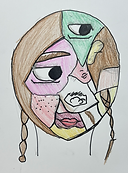






















Term 2- 2025
Junior Projects
Each week we display a small selection of junior artwork along with some context of the projects we explored. Hope you enjoy them as much as we do!
Week 10 - Abstract Watercolour with Black Ink, and Biscuit Decorating
To end the term the students got creative using our watercolour bleeds. Inspired by the random shapes that were created, they used ink to find shapes and objects in their abstraction. Encouraging the freedom and exploration of reactionary creativity, created some very interesting finished pieces.
Of course the children also got to decorate their end-of-term biscuits to celebrate the wonderful artworks completed over the past 10 weeks, using the biscuits as a canvas (though in some instances the biscuits just become a platter 😅).
Happy holidays and stay creative!






































Week 9 - Stylised Watercolour Leaf Drawing
Inspired by the transition between Autumn and Winter, we explored the abstraction of watercolour, using our learnt watercolour bleeding technique (water first, then paint). Students studied their chosen leaves we collected from the environment, taking note of the veins and structures. They transferred the details onto their artwork using black pen, creating a bold contrast to create these very effective looking pieces.






























Week 7 & 8 - Paper Mache Bird Sculptures

Publicly sourced image - example only
Over the past two weeks, the junior students have worked hard to complete their paper mache sculptures. In the first week, students built their birds form using newspapered paper mache. In the second week they painted and added personality to their birds, drawing inspiration from different bird species. Some students also created environments for their bird to live in.
Super cute! The older classes loved seeing these little creatures develop.













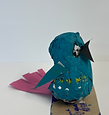















Week 6 - Miniature Acrylic Paintings

Publicly sourced image - example only
This week the Junior students were inspired by Natasha Bieniek's miniature landscapes. Students were taught how to create a small canvas-like surface - simple enough to make at home! Using their smallest brushes, students looked at how to create fine detail at a smaller scale with some wonderful outcomes on these 7 x11 cm surfaces.



























Week 5 - Stained Glass Window Art

Publicly sourced image - example only
This week the juniors created their very own stained glass windows - tracing over their chosen designs (or freehand) forming the outlines, using ink paints on clear acrylic to achieve this wonderful effect. Stained glass windows have been used for thousands of years, first gaining popularity in the years 1150-1500 to tell stories. Make sure to hold your piece up to the light to get the full effect, well done everyone!



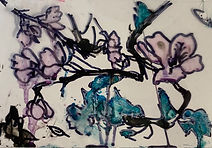






























Week 4 - Travel Tic-Tac-Toe

Publicly sourced image - example only
The junior students designed their very own Tic-Tac-Toe game boards and pieces. Students were encouraged to pick a theme for their game set using contrasting or complementary images, resulting in many unique and colourful compositions. This project demonstrated that art can be functional and interactive. Well done everyone, and have fun enjoying your new portable game set!













Week 3 - Mothers Day Watercolour and Crafts
Publicly sourced image - example only


The students created some lovely crafts dedicated to their mothers/significant women in their life. They explored abstract watercolour techniques including 'bleeding', wet-on-dry, and layering, finalised with some black ink to make the bookmark design pop. Students also had the opportunity to play with a new art product, a drawing paper sponge, adding water to chosen areas to create a 3D composition, which they loved!





Week 2 - Watercolour Octopus Workshop


Artwork by Shirley Usuga
Artwork by Shirley Usuga

Publicly sourced image - example only
Students delved into the techniques used to create this beautiful sea creature. Similar to the tiger workshop from last term, students examined the geometric shapes; breaking down the object into simple shapes and lines; adding the overall form of the octopus, finalising the composition with watercolour and ink pens.
Here are some of the awesome results from this week!
























Week 1 - Charcoal Still Life Sketches

Publicly sourced image - example only

Publicly sourced image - example only
To commence term 2 the juniors experimented using charcoal, learning different ways to use the material to achieve their desired effects. Students got to study the techniques used to create still-life drawings, drawing inspiration from the masters. We encourage students to create their own composition and style while teaching them the fundamental basics including how to create shadows, shape, a light source and depth within their artworks. A great start to the term!

















Term 1- 2025
Junior Projects
Each week we display a small selection of junior artwork along with some context of the projects we explored. Hope you enjoy them as much as we do!
Week 10- Easter Origami and Biscuit Decorating

Publicly sourced image - example only
For the final week of term 1, students had the opportunity to use biscuits as their canvas as a part of the end-of-term celebration. Students also created their own Origami Basket, perfect for holding trinkets or easter treats.




Week 8 an 9 - Cork People and Their Diorama Environments

Publicly sourced image - example only
These two weeks the students made characters using bottle corks and created an environment for them to live in. This project spanned across two weeks and demonstrated to the juniors how recycled materials can become useful materials in art; encouraging students to find inexpensive ways to be creative on their holidays. All juniors came up with their own unique scenes, ending up with very imaginative compositions and story lines.


















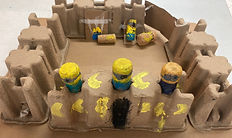






Week 7 - Kawaii Sketches and DIY Art Journal

Publicly sourced image - example only
This week students explored the techniques used to create the popular Japanese style of 'Kawaii' art. Using rounded edges and cute facial expressions, the students learnt how to create the adorable plump characters. The word 'Kawaii' is a Japanese word which translates to 'cute'. Students also learnt a simple way to create a little note book for their drawings.



















Week 6 - Disrupted by Cyclone Alfred
This week students were supposed to investigate abstract negative spaces, however due to the unfortunate circumstances of Cyclone Alfred, the lessons that were run this week were more free-time orientated.
Week 5 - Cyanotype Printing

Publicly sourced image - example only
This week students experimented with Cyanotype - a sun printing technique. Originating in Greece and known as the worlds oldest from of photography. This art form utilises the UV rays, developing the chemicals on the paper. Students focused on the positive and negative spaces using materials found from the environment to produce the negative spaces imprinted into forming the design.






















Week 4 - Clay Imprinting

Publicly sourced image - example only
This week students explored the clay technique of imprinting using found materials from the environment. Students scavenged outside to collect leaves, flowers and seeds which were then pressed into their clay pieces, leaving an impression on the material. After students were satisfied with the composition of their piece, they painted them to complete their projects.









Week 3 - Realistic Tiger Sketches

Publicly sourced image - example only


Artwork by Shirley Usuga
Artwork by Shirley Usuga
This week, students learnt how to break down complex subject matters into more manageable geometric shapes, making it easier to complete complex artworks. Working step by step -
1.Students found the general shapes found in the tigers face.
2. Connected them to establish the figure.
3. Added the details and shadowing.
This weeks project built of last week, emphasising the use of shadows on 3D objects within art.


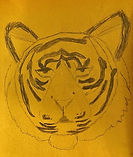













Week 2 - Geometric 3-D Shading in Graphite
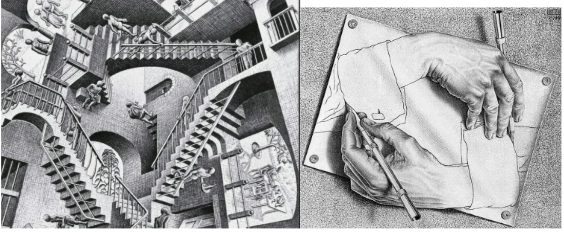
This week, students learnt how to create the illusion of 3D shapes by creating shadows. Using hard and soft graphite pencils, we looked to Escher's surreal artwork where he used line work and shading techniques. The students explored directional lighting and shadows to develop this versatile technique which can be used through many mediums and compositions, to create a more realistic appearance. Students will further develop these techniques, in next week's project.

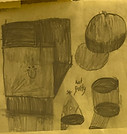









Week 1 - Northern Lights in Soft and Oil Pastels

This week students explored new materials including oil pastel and soft pastel to create a gentle and colourful composition. Taking inspiration from the famous Impressionist artists Edgar Degas and his use of expressive oil/soft pastels. Students explored techniques of the materials, including smudging the soft pastels, flicking paint off a toothbrush to create stars and creating reflection of light on water.










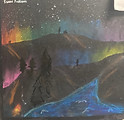

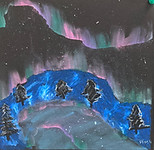



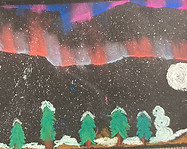

Publicly sourced image - example only
Term 4 - 2024
Junior Projects
Each week we display a small selection of junior artwork along with some context of the projects we explored. Hope you enjoy them as much as we do!
Week 10 - recycled material stockings and biscuit decorating
This week the students celebrated the end of the term by decorating biscuits, a tradition the juniors always look forward to. As well as decorating biscuits, the students also decorated handmade stockings made from recycled materials (paper grocery bags) and other ornamental pieces.


Week 9 - Festive Decorations
This week the juniors made ornaments celebrating the Christmas season. encouraged to create art pieces they like enough to decorate their environment with. Using repurposed textile materials the students were able to strengthen their fine motor skills by using a blunt needle to thread their individually cut pieces of material onto a string. This weeks lesson inspired many unique and creative designs.









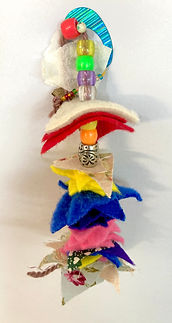



Week 8 - Pointillism drawings
Exploring Pointillism (the art of painting with dots, originating in 1886), Inspiration from Georges Seurat. The juniors used repetitive small dots to create their compositions, building on their colour theory knowledge. We also covered a new concept - optical colour mixing (when colours appear to mix together when placed in close proximity of each other, appearing mixed without physically mixing colours).


Publicly sourced image - example only



Week 7 - Watercolour and Ink Paintings
Watercolour is a versatile medium, allowing the students to incorporate different techniques including wet on wet (applying watercolour onto a wet page), splattering (tapping their paintbrush against another to create small repetitive markings), and bleeding (adding paint to an area which currently holds wet paint). Students were also encouraged to create the watercolour component of their piece without too much critical thinking. Once dry, they found shapes and forms, bringing them to life within their works using ink.





Week 6 - Paperbark Painting
Students incorporated natural materials into their artworks. Drawing inspiration from one of Australia's oldest forms of artwork originating from Australia's First Nations Peoples, who used paper-bark (Melaleuca tree) and charcoal to create artworks and communicate stories. Students were encouraged to create their own unique composition focusing on tonality (adapting the soft natural lights and darks to create contrast), textures (rough and smooth bark), direction of line, and naturally occuring shapes.


Publicly sourced image - example only






Week 5 - Painting Gradients
This week students practiced gradient techniques by blending the three primary colours (Magenta, Yellow and Blue) to then create the secondary colours (purple and orange). The students utilised the gradients to form lovely sunset-like backgrounds, finishing the composition with a silhouette (a shape that is absent of light). Students were able to choose between stencils or free-hand painting the silhouette they incorporated into their piece, which became the main point of focus within their compositions.











Week 4 - Collage
Inspired by Henri Matisse's cut out works, students have been explored collage, a historical technique which made a reappearance again in the early 20th century. Collage - is process in which pieces of paper, fabric, photographs and other ephemera are arranged and adhered to another surface. We discussed the many styles of collage, including assemblage, mosaic, 3D, photomontage and digital collage. We also observed how images can inspire further ideas and creations and can be used to tell more than one story.
It is always exciting watching the young students becoming animated and focused, when they get a chance to be conceptually creative!

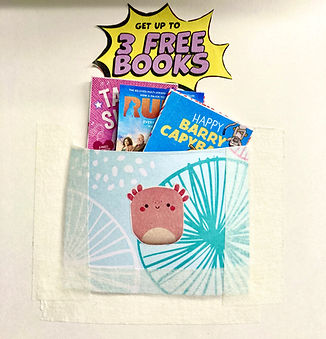








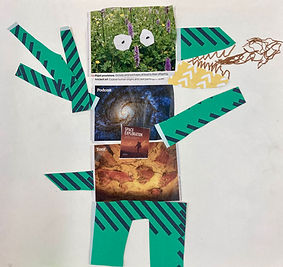








Week 3 - Van Gogh Styled Landscapes
Inspiration by the textural techniques used by Vincent Van Gogh. Van Gogh drew inspiration from Japanese paintings made using linoprint (prints created by carving the image into a board which was then used to transfer the composition onto paper). The students achieved this look by using forks to scratch into the wet paint, leaving interesting patterns and lines within the work. We also discussed a composition that incorporated a foreground, mid-ground and background sections.





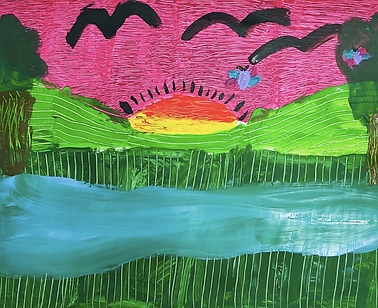









Week 2 - Origami Cranes with Shobori Paper
Origami - is the art of paper folding which originated in China nearly 2000 years ago, it then became a popular art from in Japan in the 6th Century to decorate temples and shrines. This week we learnt how to make Origami cranes (representing good fortune and good health), using Shobori paper (an Eastern method of tie dying using twisting, tying or stitching to create beautiful patterns usually with an indigo coloured dye). The students then used watercolour paint to create a habitat for the cranes they made.




Publicly sourced image - example only




Week 1 - Charcoal techniques
This week the students explored the various techniques used to when using the charcoal medium. Our projects were inspired by artwork made by our own in-studio artist, Tanya (Sarianti) Ashworth. Students experimented with willow, compressed charcoal, charcoal pencil, as well as introducing them to charcoal white and brown charcoal. Blending, crosshatching, scumbling, scribbling, and gradient mark making were then used in their final pieces.






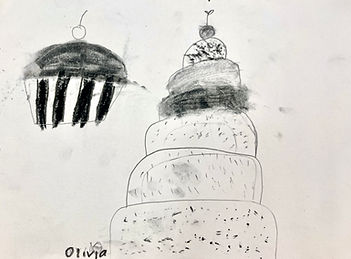

Artwork by Tanya Ashworth (Sarianti designs)
Artwork by Tanya Ashworth (Sarianti designs)



Junior Projects - Term 3 2024
Week 10 - Ripple/Contour Art
In our final week we studied the idea of contour drawing, the receptive outlining of shapes to create movement, expression, and directional line. We examined the work of American artist Melvin Clark b. 1944 who used sharp and colourful contour to express vibrant movement and sound to the visual representation of Jazz.
The students also did their traditional end of term biscuit decorating!



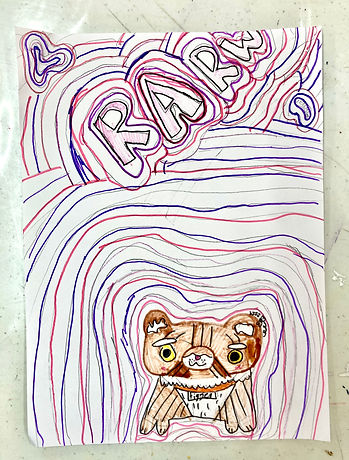

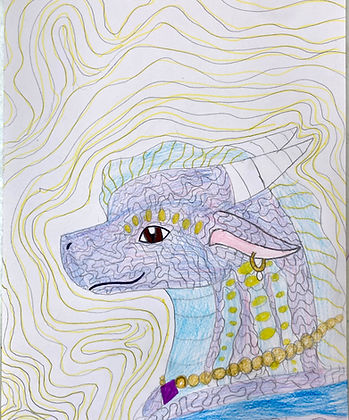


Week 9 - Abstract Art
Using acrylic paint and repetitive geometric shapes, the young students created abstracts in the style of Russian artist Vasily Kandinsky, (b. 1866) whose expressive abstract style reflected ideas of the landscape in the utopian and universal language of geometric forms.










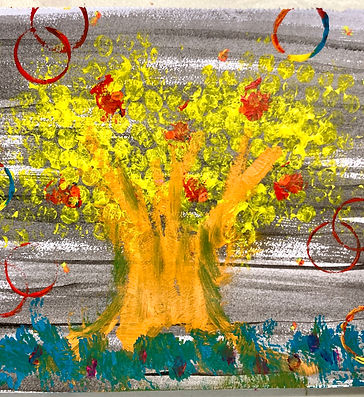
Week 8 - Message in a Bottle (Father's Day 2024)
Using porcelin paint the children painted a variety of small bottles and jars, and created a message in the bottle for Father's Day, or to express their appreciation to a significant person in their life.




Week 7 - Ephemeral Art
Artist of Influence - British artist Andy Goldsworthy (b. 1956)
The students had a great week this week, making art outside using nature as their palette and canvas!
Ephemeral art - a temporary art to be appreciated in the moment, can be merged with the natural environment, landscape or natural materials to create an artwork that emphasizes the beauty of the surroundings. It can be created with a particular location in mind, taking into consideration the topography, climate, objects, or cultural characteristics of the site.

Publicly sourced image - example only







Week 6 - Sgraffito
This week students investigated the technique of Sgraffito, originally from Italy, the word Sgraffito translates as "to scratch". This technique challenges students to think ahead of time, selecting the background colour of their artwork before creating the focal point. Students used oil pastels for the background, and black/white acrylic paint that was them scratched into with a pencil, bringing the pieces to life. Some students chose to dedicate their artworks to their dad's in preparation for Fathers day.







Week 5 - Comic Strips and Storyboards
This week we looked at making comic strips and storyboards. We learnt that how storyboards have been used throughout history to visually tell stories and how these simple frames are now used to create to make comic strips, animation and to assist people in making films.
Using these examples, the students made their own stories. It was great seeing the excitement and enthusiasm that came from their creative ideas.







Publicly sourced image - example only



Week 4 - The Functional and the Decorative of Everyday Objects - Pinch Pots
This week the students used the designs that they created last week to constructed their own decorative/functional object, using the pinch pot clay method in air drying clay. They then finished the work with their painted design in acrylic paint.



Week 3 - The Functional and Decorative - Everyday Objects
In our week 3 project, we looked at the patterns and decorations used on everyday objects. The use of functional designs are evident across all cultures throughout history, such as these examples of jugs and vases.

Using these historical influences the students designed their own functional item's patterns and shapes, in a 2D drawing. The designs created this week will be used by the students to construct their own earthenware sculptures next week.



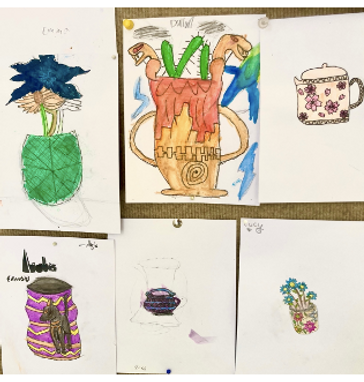
Week 2 - Surrealism
This week students explored the art movement, Surrealism. Surrealism is an art genre that originated in Europe after World War 1, where artists explored the expression of their unconscious mind. Through this movement, dream-like illogical artworks were created by artist such as the well-known Salvador Dali, Escher and Dr Seuss. The premise for this genre is making the illogical logical, pioneering the way for animation.


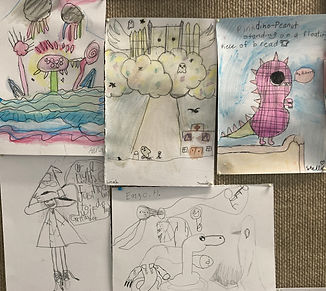





Week 1 - Water Resist Peacocks
This week students explored the technique of water resist, using oil pastel and watercolour to create a wonderful effect. Water resist works due to the oil content in the pastels repelling the water from the watercolours. When selecting our colours choices we revised complimentary colours (colours opposite each other on the colour wheel) and analogous colours (colours next to each other on the colour wheel).
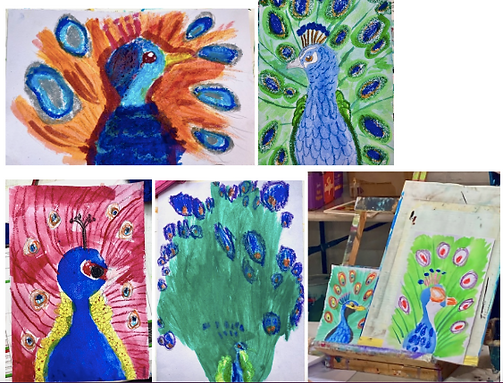


Junior Projects - Term 2 2024
Week 10 - Biscuits and Finishing Concertina Books

Week 10 we did our traditional biscuit decorating using biscuits as a canvas. We also continued to work on our Concertina books. Continuing with the Japanese theme, we filled them with our own Kawaii characters. The word Kawaii, originating from Japanese meaning cute, tiny or loveable.

Week 9 - Concertina Books
This week the Juniors explored the process of folding and constructing a small concertina book. This weeks project was inspired by the traditional Japanese practice of orihon originating from 900CE .
keeping with the Japanese theme, the pieces will be filled with Kawaii (Japanese for cute) looking at the characteristics of these animated objects. Students selected their cover designs from donated wallpaper samples



Week 8 - Watercolour leaves
This week the Juniors explored the medium of watercolour and the techniques of bleeding and drawing from observation. Students selected a leaf and studied the veins and structures before then transferring their observations onto card. The Juniors had lots of fun continuing to build their knowledge on complimentary and analogous colours within their backgrounds.



Week 7 - Quilling
This week the Juniors discovered the technique of Quilling, this technique was discovered during the15th century in Egypt. Students were taught the foundational steps of making individual shapes and techniques required to build the quilling, including how to coil the paper and form shapes. We also incorporated environments into the background of our quilling pieces to establish setting.
















Week 6 - BVAC Mural
This week we spent our time working on the mural on the BVAC (Brisbane Visual Art Community) studio's door. We discussed the difference between graffiti and murals, murals being public art produced with permission. The students blocked in coloured sections by section, focusing on industry techniques - following the prearranged design, committed to colour, shapes and the responsible use of paint. The students also designed their own mural version considering 'site specificity' meaning that they designed their artwork to connect to the site or place their artwork might reside.







Week 5 - Patterning
Quilting influenced our projects this week exploring patterning as one of the important elements of art and design. We looked at the artist Matisse who was well known for using shapes and 'cut outs' for his work. Using beautiful wallpaper designs the children cut geometric and organic shapes, creating contrasting and harmonious patterns.












Week 4 - Three-Dimensional Painting
This week was focused on creative thinking. Playing with a painted background and collaged natural objects to create a 3-D effect. While lots of beach scenes came from the available shells, there were also some very creative ideas with one shell becoming the face of mouse!
Always amazed by the works that come from the young students imagination.












Junior Class - Week 3 - Mother's Day Cards
The students creativity was directed towards mixed media Mother's Day cards. The children were encouraged to come up with designs they thought their mums' would like, we went through some of the previously learn't watercolour techniques again for a refresher. Abstracted backgrounds were created, using watercolour bleeding. The images were then added using more defined application of paint and ink. Some lovely sentiments were written inside!









Junior Class - Week 2 - Mother's Day Part 1: Hanging Pot Gift
This week we focused on gifts for Mother's day (though some students seemed keen to keep the pieces for themselves!) . We made little hanging flower pots using clay, acrylic paints, dry and fabric flowers, and leather straps. Building on clay making techniques we have covered in previous terms, the students built the shape of the pot. Then they created their own designs using the clay tools. We incorporated some of the colour combinations that work together well, that we learnt from our colour theory class we did at the end of last term. Hope you have a wonderful Mother's Day mums!









Junior Class - Week 1 - Pastel Techniques and Final Piece
In week 1, we worked with soft-pastels on craft paper, and we practiced the different mark-making technique we can use with this medium, including scumbling, cross hatching, dots, strokes, scribbles, and feathering. Choosing which mark-making techniques they thought would suit their creation they produce their own soft-pastel animal.






Junior Class - Week 10 - Biscuit Decorating and Easter Cards
This week is our usual end of term project - decorating using biscuits as our canvas, to show that we can use anything within our environment as tools for our creativity. Students also created some collaged and painted Easter cards.







Junior Class - Week 9 - Colour Theory
This week we looked at analogous colours (3 or 4 colours close together on the colour wheel) and complementary colours (colours on the opposite side of the colour wheel) to understand how to create nice balances or interesting combinations of colour.






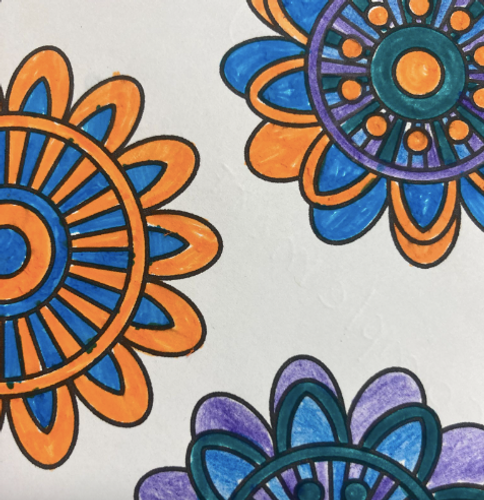
Junior Class - Week 8 - The Study of Eyes
This week (excuse the pun) we used our observation skills to study the diverse range of eye shape, size, colour within the animal kingdom and humankind. We discussed the unique features of each and why they may have any particular features. Observation is an extremely important artist skill.

The students were shown good sketching techniques and then had their choice of tonal graphite, watercolour pencil and charcoal to create a collection of eye recreations.



Junior Class - Week 6 & 7 - Clay Habitats
Over the past two weeks the students created habitats with air dry clay and found objects from our natural environment. It is always wonderful incorporating organic materials into our work and our creative thinking. The students learnt clay making techniques including slip and scoring for structural integrity.




Junior Class- Week 5 - Principals + Elements of Art and Design
Using Van Gogh's Starry Night painting as an example, we covered technicality aspects of a good artwork this week, exploring art elements. Including line, colour, tone, texture, space, form, and art design principals, balance unity, variety, emphasis, movement, pattern and proportion.











Junior Class - Week 4 - Acrylic on Canvas
In contrast to week 3, using tricky porcelain paint on the smooth surface of ceramic tiles, the students this week used the smooth consistency of acrylic paint on the textured surface of canvas. We covered the importance of using gesso (primer) and how it is applied prior to the paint application.


Junior Class - Week 3 - Porcelain Paint on Tiles
In week three we practiced painting on ceramic tiles with porcelain paint. The ceramic paint medium has been used for decoration and pattern making for thousands of years in Middle Eastern and East Asian Cultures. Using this medium, we practiced with a thick paint consistency on a smooth surface. Next week we will compare this to using a smooth, thin paint consistency on a rough surface.


















Junior Class - Week 2 - Charcoal
This week we explored the charcoal medium, in three different forms - willow (soft), pencil (medium) and compressed (hard) charcoal. Charcoal is a beautifully expressive and an awesomely messy medium. Using paper the students created these moody images by practicing the following methods:
-
Additive method - applying the pigment directly where required.
-
Eraser method - applying pigment over a broad area and then lifting the charcoal.



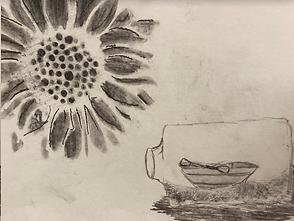


Junior Class - Week 1 - Water Colour and Ink
For our first week we bounced straight back into watercolour painting. We explored the satisfying effects achievable using abstract watercolour bleeds, contrasted with black silhouettes.






Junior Class - Week 10 – The art of food
Our final week for the term was filled with holiday related creativity, including bon bons biscuits, and paper lanterns. Our end of term biscuits decorating has become a ‘looked forward to’ tradition, acknowledging that art comes in all forms, and a canvas can come in all shapes and sizes. Happy holidays!

Junior Class - Week 9 – Watercolour holiday cards
The students created beautiful abstract watercolour paintings which were then used to make lovely, collaged shapes to decorate these hand-made holiday cards.



Junior Class - Week 8 – Sculpture: Rock Art
By popular demand, this week we made holiday related Rock Art. As always, the children often take their projects to their own creative spaces.


Junior Class - Week 7 Ancient Art Metal Medallions and Sculptures.
This week we looked at the history of Metal Art dating back to 7,000 BC and which was used throughout most of the world’s cultures to create masks, jewellery, statues, afterlife memorials, decorative interiors and exteriors and coins.
The students then made sculptures and medallions using clay and metallic acrylic paint.



Junior Class Week 6 – Jackson Pollock Inspired Painting
Paul Jackson Pollock was an American painter. An abstract expressionist, Pollock used a "drip technique" of pouring or splashing liquid household paint onto a horizontal surface. Using acrylic paint the students splattered, poured, primary colours with generous expressive movements.


Junior Class Week 5 – Drawing the Human Figure
This week’s more technical project was not perceived with as much enthusiasm as some of our more creative projects, but there was some good take aways for the students to consider when they attempt to draw figures in the future. We discussed and recreated the proportions of the figure using 2D and 3D examples. It was lovely to see some of the students surprised by their outcomes, with one very young student proudly claiming that this was the very best picture that she had ever drawn.


Junior Class Week 4 – Underwater World’s using Mixed Media
Recycling a large number of sushi trays the students created these fantastic underwater worlds! This project was similar to the incursion that Lilly-Lee ran for the Weller Hill grade 3 & 4’s last term. Utilising acrylic paint, posca pens, rocks, shells, and ceramic fish the students built these bright vibrant table decorations.

Junior Class Week 3 – Collaboration and Public Art
This week was a really interesting week where we covered a number of concepts. Primarily Public Art.
-
We discussed the history, the role, and benefits of public art but also the importance of permission.
-
We focused on the enjoyment of collaboration, where artists work together combining their different creative strengths.
-
We also looked at what is temporary or performance art – which is typically created for a spontaneous or participatory experience, enjoyed in the moment.
These concepts made for a great physical creative experience that leant itself to some lovely, combined ideas and a lot of general excitement! We thought the “Touch Grass” artwork was really relevant, with its implication to get off electronics and get amongst the real world.


Junior Class Week 2 – Abstract Painting
One of the pioneers of abstract art Wassily Kandinsky, was our inspiration for this week’s project. We looked at how to create art ‘organically’ where we leave some of the making to chance, creating an image that isn’t necessarily a recognisable picture. We discussed how this gives the audience the opportunity to have own interpretation of our artwork. Using nuts and bolts the students rolled them over the paper, and then explored how to create the balance of colours, tones, and shapes, required in Abstract Art.




Junior Class Week 1 – Textile Art
The junior students began this term full of creativity and enthusiasm and we put it to good use! Utilising donated fabrics the students created these wall hung collage works, focusing on patterning and colours.




Junior Class Week 9-10 – Collage
Over the last 2 weeks of the term, the children engaged in collage using magazine cut out of facial features making their own patch work creations (as seen below), some free time, and of course our end of term biscuit decoration creations – edible art, a great combination!


Junior Class Week 6-8 – Layering & Mixed Media on Canvas
We worked on these large canvases, some a meter long (the height of some of our junior students) over a number of weeks. These donated canvases were filled with drip painting, stencilling, and paint pens to make these dramatic and vibrant large-scale canvas works. The juniors were so focused and engaged having the opportunity to work on these canvases and easels and their creative flair was amazing to watch.



Junior Class Week 5 – Self Portraiture
Using mirrors, we encouraged the junior students to draw themselves while really studying their specific features. We used central vertical and horizontal lines to help place their features in the correct positions and then used our shading knowledge from previous weeks to create 3-dimensional effects. Children as young as prep were using these observational skills to produce portraits in their likeness.


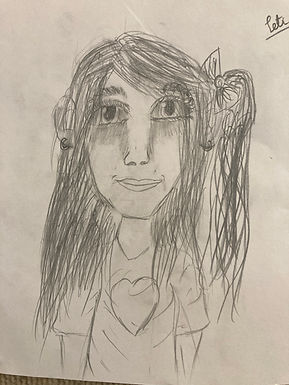




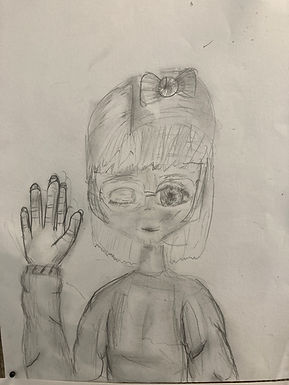


Junior Class Week 4 – Sculpture Clay
We had a free time air-dry clay session this week, where we intentionally didn’t direct the students with their project ideas. Instead, we taught them how to use clay tools and clay making techniques that would help them build their objects as they imagined them, and to make their pieces more stable.



Junior Class Week 3 - Sculpture (Rock Painting)
This week we painted rocks (by popular demand). We often ask the kids which projects they would like to do again. Rocks are always a winner. To mix it up, the children were encouraged to make a place and an animal or object. Places included stumps, skies, underwater, gardens, mushroom forests, watermelons, and gold bricks (mine-craft).What belonged in these places were just as interesting.



Junior Class Week 2 - Day and Night Scenes - Tonal Contrasts
This week we looked at tonal contrasts – the dark and light shades, and how colours change without the presence of light. We examined how this is present in the world around us by creating artwork that had contrasting day night scenes contained within a small circle. Understand the way their world works through the use of colour…the imaginations of these young people is such an inspiration!

Junior Class Week 1 - Stencil and Stamping
For our first week of the term the children had fun with stencils and stamping. We looked at how stencils and stamps are used frequently for our everyday aesthetics, art, and in functional settings.
Working in 2-3 colours the children applied 3 layers.
The first layer using sponges, brushes, rollers and other materials to make a textured background. Then they applied a layer of stamping, followed by a layer of stencilling. Some beautiful patterning and abstraction occurred!



Junior Class Week 10 – Mondrian & Biscuits
As well as our usual end of term biscuit creations, using our biscuits as a canvas we examined the artist Piet Mondrian. Born in 1906, Mondrian was one of the greatest artists of the 20th century, known for pioneering abstract art. Mondrian, reduced his imagery down to simple geometric shapes and then - experimented with equal balances of the 3 primary colours and the 2 shades (red, yellow, blue, black, and white). The children made templates using coloured tape and then transferred this aesthetic to striking bookmarks; just in time for all the reading they hoped to do on their school holidays.





Junior Class Week 8 & 9 – Korean Art
Lilly-Lee had the pleasure of having artist Yura, a lovely Korean artist who has completed a Curator Degree and has a Doctorate in Art education, majoring in Culture and History; alongside years of experience working as a Curator in Dongsan Museum in Korea. Yura attended Lilly-Lee for 2 weeks doing some Australian work experience and during this time Yura ran our junior projects, teaching the children some traditional Korean methods of painting using ink and delicate Korean paper. The children focused on semiotics - using pictures as icons to describe themselves. This visual self-portrait was a wonderful way for the children to consider how to describe themselves pictorially as a person on the inside. Communicating this with one another allowed them to share more about who they are as individuals, while becoming more knowledgeable about another culture. What a wonderful and meaningful project!





Junior Class Week 7 – Printing – Intaglio/Engraving
This version of printmaking where the mark making is imprinted into an object and then the image can be transferred. We use this type of printing with money and historical maps. The children did free-hand and used natural objects from the bushland to make their designs.





Junior Class Week 6 – Collage
This week the children had to get creative and ‘paint’ their artwork using a plethora of different materials, eg, textiles, naturally found flora, buttons, wood, sand, wool, plastics, beads, sequins etc BUT NO PAINT. The children worked hard to find different objects that they could collage to portray their picture using alternative colours and textures.


Junior Class Week 5 – Animation
Believe it or not, animation dates back to Ancient Greece! This art form that has a long history has now become a dominant art form of our contemporary society.
This week the children looked at the facial expressions of animation. Creating loose, abstract shapes by blowing liquid paint with straws, they then created a variety of facial expressions to produce an animated character. We investigated how much expression can be created by using minimal lines and markings.


Junior Class Week 4 – Charcoal
The children learnt charcoal techniques using all different varieties of charcoal pencils and charcoal sticks, both soft and hard. With fabulously messy hands the children used these skills to create distant landscapes and up-close objects of bird nests.





Junior Class Week 3 – Cactus Pots
Our Mother’s Day gifts coincided with an examination of the patterning and vivid earthy tones of South American Aztec Art. Using recycled objects, the children created some lovely low maintenance potted plants. The prosperous Aztec culture of the 15th and 16th century used highly decorative patterning for stone sculpture, architecture, pottery, fabric and body art.


Junior Class Week 2 – Art Show Project
- Layering Colours
The children’s project for the art show looked at the vibration of colours when layered together. We looked at how Margaret Olley did this in her work. The children added additional patterning of analogous or complimentary colours to create some amazing effects.


Junior Class Week 1 – Charity Artwork
In our first week, all 5 classes of our junior students (with the help of our work experience students, from one of our local high schools, Starr and Caitlyn) created a group charity project. This large scale painting was to be auctioned at the Lilly-Lee & St Luke’s Art show in May, with all proceeds going to Mummy’s Wish, a charity that cares for mum’s with cancer. This project was designed to teach the children that our artistry can be used to bring benefit to others in a meaningful way. The children’s artwork ‘My Brisbane’ raised $175, what wonderful teamwork and community spirit!

Junior Projects - Term 1 2023
Junior Class Week 10 – Bookbinding
We are very lucky to have the Queensland Bookbinders sharing our studio space at BVAC. With mass production, bookbinding like many crafts is becoming a dying art. Our connection with the Bookbinders Guild has given us a wonderful opportunity to share this skill with the junior students for their last week of the term. We have also been very lucky to have work-experience high school students join us this week who have helped us run the junior classes.
Bookbinding - using traditional methods and traditional materials of paper, card, scrim, backing, glues, and thread. The children made their own stitched spined books.
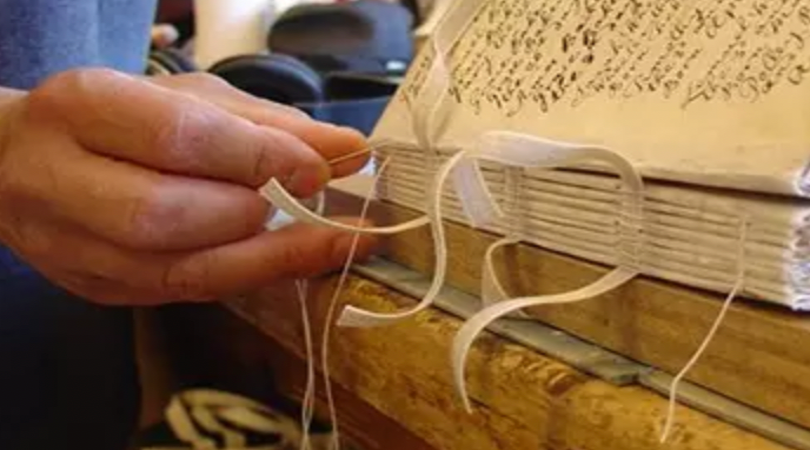

Junior Class Week 9 – Biscuits
Usually, we do our biscuit decorating on the last day of the term. However, this term we will have two grade 11 students from Cavendish Road High School doing work-experience with us, so we will be doing our biscuits one week earlier and something more time intensive next week.
Every week we hone-in on the variety of ways we can be creative by utilising lots of different materials and ideas. Our end of term biscuits provides both an exciting conclusion to our term whilst letting the children see that creativity can be much more than paint and paper. Anything can be a canvas!

Junior Class Week 8 – Upcycling
Using donated hot chip cups, week 8 focused on Australian wildflowers. There is a nice connection between recycling in order to be environmentally considerate and being inspired by our natural world. Recycled materials intentionally make up a large portion of the materials used in our Lilly-Lee projects, as the creative art can have a high carbon footprint. It is great when creativity and environmental consciousness can overlap.







Junior Class Week 7 – Mixed Media Night Skies
The children got excited this week playing around with lots of mediums to create some spectacular night scenes. We started with brushing and splattering on an acrylic paint undercoat, then applied pastels, oil pastels, and charcoal; and finally blended the colours with blending sticks to create some vivid outcomes. Mixed media always brings out their amazing creativity!







Junior Class Week 6 – Puppets
Again, this week we looked at another art form with a long history. Puppetry has been used by makers and creatives to tell stories since the 5th Century BC, however it quickly became an important story telling medium in many countries in ancient times and even in more recent times. Two dimensional puppets were some of the earliest forms of puppetry.
The children created their own versions of 2D puppets or shadow puppets using paper, watercolour paint, oil pastels, felt pens, and wooden sticks. We used the wax resist technique of using the oil pastels to make our first layer of pattern. The oil pastels resisted the watercolour paint that went on as a second layer, creating amazing effects. The children then had fun using their pieces. See some of the wonderful outcomes below.








Junior Class Week 5 – Mosaics
Mosaics are one of the oldest forms of art, dating back to ancient Mesopotamia, 3000 BC. Spreading to Ancient Greece, Rome, and the Middle East it is now a method of art that is used world-wide. Long lasting images were made from small cubes of ceramic tiles, stones and glass. As with most art, Mosaics were not just used as decoration, but also to tell stories.
Students used small strips of paper, a guillotine, cork coasters, and mod-podge glue to create their own Mosaics. We also discussed what would be involved in making a complex pattern for a large-scale mosaic, so using graph paper, the students produced their own interesting patterns.



Junior Class Week 4 – Life Drawing
Drawing from life is an important drawing process. Copying from photographs and working from our imagination are also important methods but the observational skills that comes from drawing a 3D object from life can identify things we don’t necessarily get to see.
Our life drawing models in this instance came from the beautiful environment in and outside our studio. A skink, and insects including, a cricket, a dragonfly, ants, and flora which makes up their habitats. We followed up drawing what we saw, with what we know or imagine their habitats would look like and then created what we saw in a 3D form using Packing Popcorn. Some very interesting things were discovered in this observational process.



Junior Class Week 3 – Stain Glass Windows
Stainglass window’s began with the Ancient Romans and Egyptians, but then became widely used throughout Europe and the rest of the world. Used to create beautiful architecture, decorations and religious storytelling, stained glass work’s on the coloured transparent glass and its interaction with light. Influenced by this interaction and building on the colour mixing we did in week 1, we got creative with acetate, paint pens, ink, and porcelain plate templates. See some of the wonderful outcomes!






Junior Class Week 2 – Glazes and Colour Theory
Second week saw us diving straight into colour theory. Playing with glazes and mixed media, we investigated primary colours-mixing to create our secondary colours. We used recycled music paper, sharpies, and layers of transparent acrylic paint. A great project and knowledge base that we will utilise further in week 3.


Junior Class Week 1 – Weaving
Textile art has a long history of cross over between function and art. Weaving has been a source of fabric production and design from 3400 BC. We looked at how we use weaving in our everyday and practiced weaving using the practicality of paper strips and mixed media for the decorative aspects.
Loving the creative ideas, even Darth Vader’s outfit can be improved on with some weaving!




